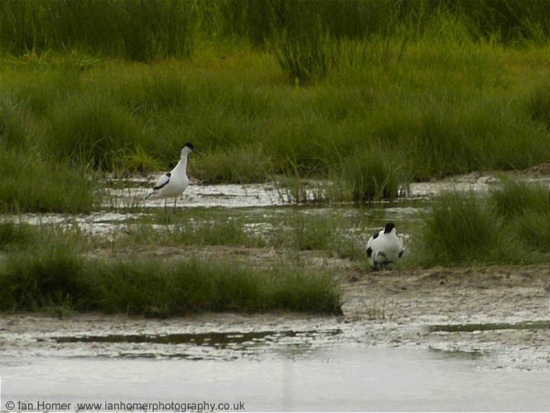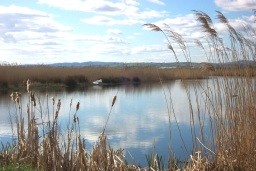Overview
This new wildlife reserve, opened in March 2000, on part of the tranquil Gwent Levels on the edge of the City of Newport. It was created as mitigation for the loss of mudflats of Cardiff Bay.
Birds
Notable Species
The new reedbeds, saline lagoons and wet grasslands have already attracted a wealth of wetland birds including internationally important number of overwintering Shoveler and Pintail with numbers of Wigeon and Teal rapidly approaching the same level of importance. Other wintering wildfowl include Gadwall, Pochard and Goldeneye, with the occasional Scaup.
Bittern may be seen at the Uskmouth Reedbeds in winter along with Hen Harrier and Short-eared Owl. Up to 50,000 Starling use the reedbeds to roost in winter.
The scrub around the reedbeds has Cetti's Warbler which are resident all year, a recent survey revealed around 70 singing males! Also Reed Warbler and Sedge Warbler in summer along with a few Grasshopper Warbler in the reedbeds through the summer. A good number of Lesser Whitethroat are found around the hedgerows during the summer and are joined passage Redstart, Whinchat and Flycatchers during the spring an autumn.
Lapwing, Redshank, Oystercatcher, Little Ringed Plover and Ringed Plover breed on the wet grassland and lagoons. Avocet bred here, for the first time in Wales, in 2003 with the colony getting larger every year. Little Egret are resident all year and are breeding near the reserve. Hopefully in the coming years Bittern and Marsh Harrier will join the vast list of breeding birds, with the latter being seen regularly through migration times with some staying for a few weeks. In winter 2008-09, a juvenile Marsh Harrier wintered on the reserve, this is Gwent's first wintering Marsh Harrier.
Rarities
Past rarities include, Hudsonian Whimbrel, Broad-billed Sandpiper, Black-winged Stilt, Temminck's Stint, Baird's Sandpiper, Pectoral Sandpiper which are almost annual; Semipalmated Sandpiper, White-rumped Sandpiper, Long-billed Dowitcher, Collared Pratincole, Eurasian Spoonbill becoming quite regular through the sping and summer, Glaucous Gull, Green-winged Teal, Ring-necked Duck, American Wigeon, Western Cattle Egret, Great White Egret, Squacco Heron, Common Crane and White Stork.
Also the vast reedbeeds are recognised as nationally important for Aquatic Warbler on migration and the surrounding scrub has had Yellow-browed Warbler, Firecrest, Barred Warbler and most recently a Subalpine Warbler.
Check-list
Birds you can see here include:
Mute Swan, Bewick's Swan, Greylag Goose, Canada Goose, Barnacle Goose (feral), Brent Goose, Shelduck, Wigeon, Gadwall, Common Teal, Mallard, Pintail, Garganey, Shoveler, Pochard, Tufted Duck, Goldeneye, Ruddy Duck, Red-legged Partridge, Pheasant, Little Grebe, Great Crested Grebe, Cormorant, Bittern, Little Egret, Grey Heron, Spoonbill, Western Marsh Harrier, Hen Harrier, Sparrowhawk, Buzzard, Osprey (passage only), Kestrel, Merlin, Peregrine Falcon, Water Rail, Moorhen, Coot, Eurasian Oystercatcher, Pied Avocet, Little Ringed Plover, Grey Plover, Northern Lapwing, Red Knot, Sanderling, Little Stint, Curlew Sandpiper, Dunlin, Ruff, Jack Snipe, Common Snipe, Black-tailed Godwit, Bar-tailed Godwit, Whimbrel, Eurasian Curlew, Common Sandpiper, Green Sandpiper, Spotted Redshank, Common Redshank, Common Greenshank, Wood Sandpiper, Ruddy Turnstone, Arctic Skua, Black-legged Kittiwake, Black-headed Gull, Little Gull, Mediterranean Gull, Common Gull, Lesser Black-backed Gull, European Herring Gull, Yellow-legged Gull, Great Black-backed Gull, Black Tern, Common Tern, Arctic Tern, Stock Dove, Common Woodpigeon, Eurasian Collared Dove, Common Cuckoo, Western Barn Owl, Little Owl, Tawny Owl, Short-eared Owl, Common Swift, Common Kingfisher, Green Woodpecker, Great Spotted Woodpecker, Eurasian Skylark, Sand Martin, Barn Swallow, Western House Martin, Tree Pipit, Meadow Pipit, Rock Pipit, Water Pipit, Yellow Wagtail, Grey Wagtail, Pied Wagtail, White Wagtail, Eurasian Wren, Dunnock, Robin, Black Redstart, Common Redstart, Whinchat, European Stonechat, Northern Wheatear, Eurasian Blackbird, Fieldfare, Song Thrush, Redwing, Mistle Thrush, Cetti's Warbler, Grasshopper Warbler, Aquatic Warbler, Sedge Warbler, Common Reed Warbler, Blackcap, Garden Warbler, Lesser Whitethroat, Common Whitethroat, Common Chiffchaff, Willow Warbler, Spotted Flycatcher, Bearded Tit, Long-tailed Tit, Blue Tit, Great Tit, Coal Tit, Eurasian Treecreeper, Eurasian Jay, Eurasian Jackdaw, Rook, Carrion Crow, Common Raven, Common Starling, House Sparrow, Chaffinch, Brambling, European Greenfinch, European Goldfinch, Eurasian Siskin, Lesser Redpoll, Eurasian Bullfinch, Reed Bunting
Other Wildlife
The Reserve is also an excellent place to see other wildlife, such as orchids, butterflies, dragonflies, Otter and Water Shrew. A Walk around the reserve in mid summer should produce numerous Clouded Yellow and Scarlet Tigers and even the Cream Spot Tiger. Moth trapping events are sometimed run during the summer and will get up close and personal with species such as Elephant Hawkmoths and some wetland speciallities.
Site Information
History and Use
The reserve was formally ash lagoons for the nearby steelworks and farmland. The ash lagoons are now the reedbeds and the farmland now the goldcliff pools and wet grassland area which support a range of breeding and wintering waders and wildfowl. The new RSPB centre which opened in March 2008 now has thousands of school children visit each year to learn about the wildlife around newport.
Areas of Interest
The Goldcliff lagoons [Map]are where you'll find a vast majority of waders. High tide is by far the best but alot of wader species are present throughout the day.
The area alongside boat lane is particularly good in winter for the large numbers of lapwing and wigeon. Almost 3000 lapwing were present in this area last winter! Boat lane is also worth a look if Marsh harriers have been reported. Uskmouth reedbeds are the other favoured site for Marsh harrier along with Hen Harrier in the winter.
The star bird of the reedbeds at the reserve are the Bearded Tits. They tend to favour the reeds east of the lighthouse along the seawall, but they do move around.
The scrub along the seawall is also good, especially in the spring when migrants are returning. Check for Grasshopper Warbler in the brambles and along the rocks for Northern Wheatears.
Access and Facilities
Access is very easy with surfaced paths around the reedbed and grasslands. Goldcliff is a little uneven with just natural paths through the grass. The reserve has numerous viewing screens looking over the pools at Uskmouth and the saline lagoons at Goldcliff.
A large Visitor centre was opened in March 2008 which is run by the RSPB. There's a shop, including a good book shelf, and a cafe looking over a new scrape and wet grassland area.
Grid reference: ST334834
Contact Details
- Tel: 0845 1306 229: Countryside Council for Wales; for enquiries about the nature reserve
- Tel: 01633 636363 visitor centre enquiries
External Links
- RSPB: Newport Wetlands
- BBC: Newport Wetlands
- Friends of Goldcliff Lagoons
- Birdforum Local Patch thread: Newport Wetlands NNR
- : A short film showing the reserve
Maps
- Newport Wetlands on Streetmap
- Goldcliff Lagoons on Streetmap
- Map of lagoons with hides and viewing platforms marked
Content and images originally posted by luke
Reviews
luke's review great place to go birding, plenty about most times of year, great in winter with loads of wintering ducks and wader, reasently went there on the BF bash, we had 63 species in a day ranging from avocet to wren, good day out Pros
- good variety of species
Cons
- no hides at uskmouth and only screens at goldcliff (this is no longer the case: there are three hides, as well as four screens, at Goldcliff - Oct.2018)
luke's review A three Million pounds visitor centre is currently being constructed at the reserve entrance. its due to be open by next autumn. (2007)






